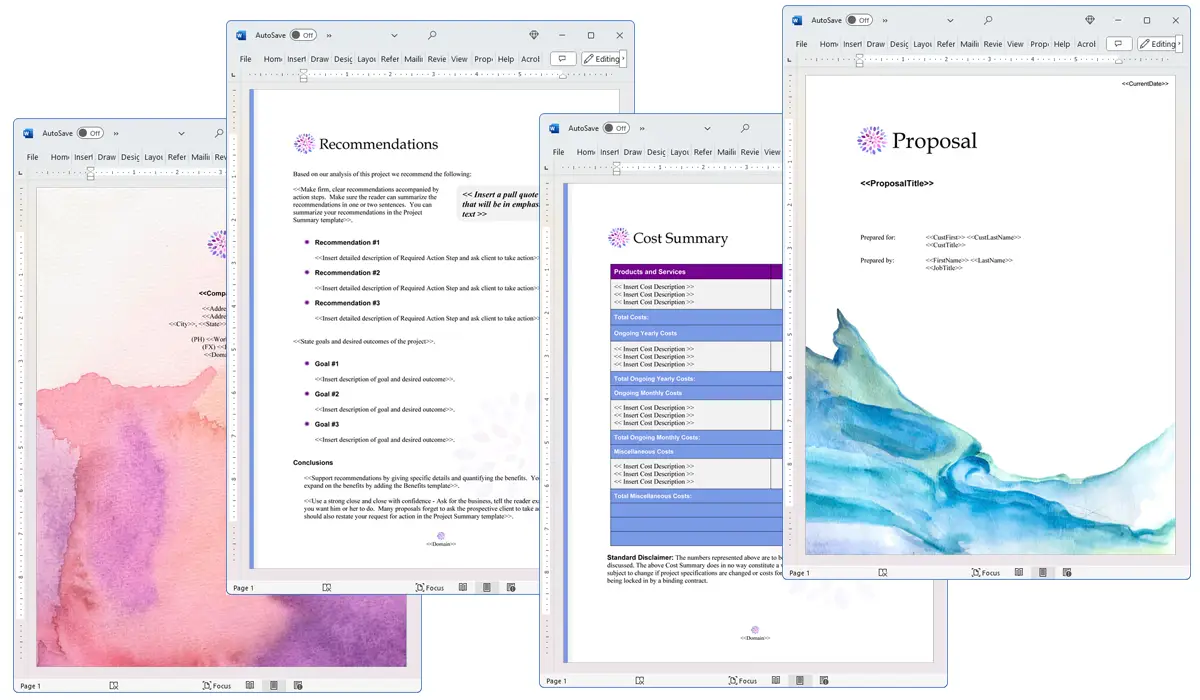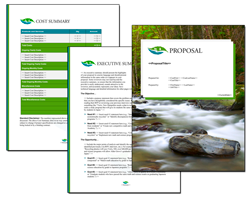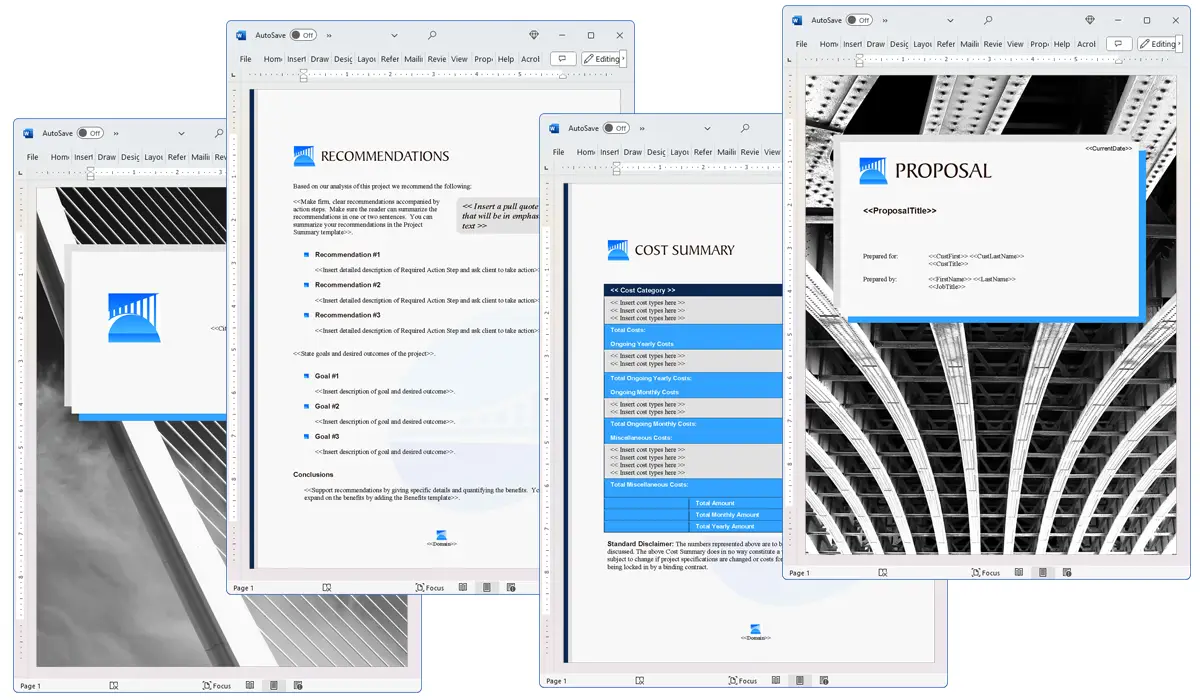What is the Reverse Logistics chapter used for?
Proposal Kit Professional Bundle adds more design themes, all six Contract Packs,
a project management library, and Expert Edition software.

Illustration of Proposal Pack Artsy #9
We include this Reverse Logistics chapter template in every Proposal Pack, along with thousands more. You assemble this chapter with others in various combinations to create custom-tailored business proposals, plans, reports, and other documents. Proposal Packs apply custom visual designs to the templates, giving the final documents a consistent professional finish.
 DOWNLOADABLE, ONE-TIME COST, NO SUBSCRIPTION FEES
DOWNLOADABLE, ONE-TIME COST, NO SUBSCRIPTION FEES
Overview of the Reverse Logistics Chapter
The Reverse Logistics chapter is an important part of a business proposal document that focuses on the management of goods after they have been sold and delivered. In business, it's not just about getting products to the customer; it's also about handling them after they've reached their destination, especially if they need to be returned, repaired, or recycled. This chapter enables businesses to outline their strategies and procedures for managing these processes effectively.
How is the Reverse Logistics Chapter Used?
In a business proposal, the Reverse Logistics chapter is used to provide a detailed plan of how a company will handle the return or processing of their products after delivery. This could include how the business plans to manage returns, conduct repairs, refurbish used or broken equipment, and recycle products or components. Including this chapter in a proposal demonstrates to potential clients or partners that the company is thoughtful and comprehensive in managing the full lifecycle of its products, thereby enhancing its reliability and commitment to sustainability and customer service.
What is Included in the Reverse Logistics Chapter?
Typically, the Reverse Logistics chapter includes several key elements:
- Return Policy: Detailed description of how products can be returned by customers, including the timeline, conditions, and the process of return.
- Repair Services: Outline of how the company handles warranty repairs or general refurbishment of products.
- Recycling and Disposal: Strategies for the environmentally responsible disposal or recycling of used products and components.
- Cost Management: Analysis of the costs associated with reverse logistics and how these are minimized or absorbed by the company.
- Technology and Systems: Information on the use of technology and systems to track and manage returned goods efficiently.
Use Case Examples for the Reverse Logistics Chapter
- Supply Chain Management: Proposals aimed at enhancing supply chain efficiency by integrating advanced reverse logistics strategies to reduce waste and costs.
- Logistics Services: For companies providing logistics solutions, showcasing their capability to handle returns effectively, which is critical for e-commerce businesses.
- Transportation: In proposals related to transportation services, detailing how goods can be efficiently collected, returned, or recycled as part of the transportation contract.
Key Takeaways
- Comprehensive Planning: The Reverse Logistics chapter helps businesses demonstrate their capability in managing the lifecycle of their products beyond the point of sale.
- Enhanced Credibility: Including this chapter enhances a company's credibility by showing a commitment to customer service and environmental responsibility.
- Cost Efficiency: It discusses ways to handle reverse logistics in a cost-effective manner, which is crucial for business sustainability.
- Technological Integration: Highlights the use of technology in tracking and managing returns, repairs, and recycling of products.
- Versatility: This chapter is relevant across various industries including supply chain, logistics, and transportation, showcasing its broad applicability.

Illustration of Proposal Pack Aqua #7
 What Our Clients Say
What Our Clients SayGreat product and I look forward to using it often."
 4.7 stars, based on 845 reviews
4.7 stars, based on 845 reviewsRelated Chapters

The Reverse Logistics chapter and other chapters are integrated into a Word document as illustrated here in the Proposal Pack Infrastructure #3 design theme. There are hundreds of design themes available, and every design theme includes the Reverse Logistics chapter template.
A proper business proposal will include multiple chapters. This chapter is just one of many you can build into your proposal. We include the complete fill-in-the-blank template in our Proposal Pack template collections. We also include a library of sample proposals illustrating how companies in different industries, both large and small, have written proposals using our Proposal Packs. This template will show you how to write the Reverse Logistics.
We include a chapter library for you to build from based on your needs. All proposals are different and have different needs and goals. Pick the chapters from our collection and organize them as needed for your proposal.
Using the Proposal Pack template library, you can create any business proposal, report, study, plan, or document.
 Ian Lauder has been helping businesses write their proposals and contracts for two decades. Ian is the owner and founder of Proposal Kit, one of the original sources of business proposal and contract software products started in 1997.
Ian Lauder has been helping businesses write their proposals and contracts for two decades. Ian is the owner and founder of Proposal Kit, one of the original sources of business proposal and contract software products started in 1997.By Ian Lauder
 Published by Proposal Kit, Inc.
Published by Proposal Kit, Inc.


 Cart
Cart
 Facebook
Facebook YouTube
YouTube X
X Search Site
Search Site